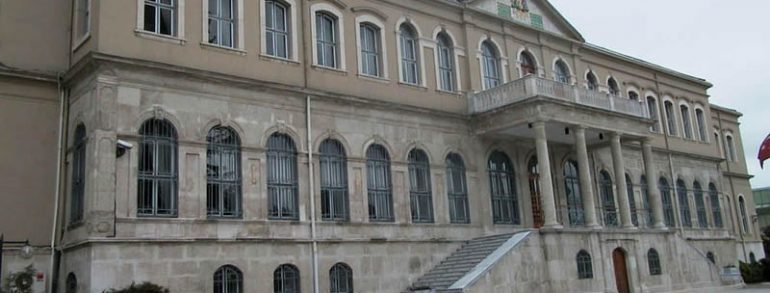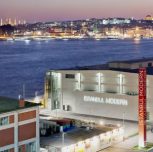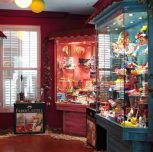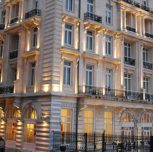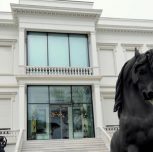The Military Museum is located in Harbiye, Istanbul. During the last period of the Ottoman Empire, it is the site of the Ottoman Imperial Military Academy. It is composed of the historical buildings of“Military Museum & Culture Center” and “The Chief of Staff Military History and Strategic Research Ministry (ATASE).” The adjacent buildings were added to the main structure later.
After the conquest of Istanbul by Sultan Mehmed II (1432-1481) in 1453, the Saint Irene Church was turned into an armory. The building was restored by Sultan Ahmed III (1673-1736) and the arms were arranged in a regular manner in 1726. In doing so, it laid the foundation for the Military Museum. After regulations made by Sultan Ahmed III, the inscription, “Daru’l Esliha” (Ammunition), was put on the entrance door of the building. It was looted by the Cebecis (armourers) during the deposition of Sultan Selim III (1789-1807) in 1807. After the abolition of the Janissary Corps (Yeniçeri Ocağı), many historical items held by the Museum belonging to the janissaries were demolished during the unrest. After all these events, the building gradually lost its previous significance and was turned into a storage facility for military affairs and was used as an armory later. Afterwards, when items were collected from the Saint Irene Church by the Armory Marshal Ahmed Fethi Paşa, the museum was opened in 1846 and in the literal sense, it was the first modern museum building consisting of two sections called Mecma-i Esliha and Mecma-i Asar-ı Atika. Unfortunately, it was again turned into an armory during the reign of Sultan Abdülaziz (1861-1876). The materials exhibited in the Mecma-i Esliha section during that time make up the core collection of the current museum. These include, army materials such as guns, axes, swords, helmets, and army scales. On the other hand, the materials in the section of Mecma-i Asar-ı Atika were added to the collection of the Archeology Museum, including many items, such as mummies brought from Egypt, tiling works, inscriptions, and sarcophaguses.
After the proclamation of the Second Constitutional Monarchy regime in 1908, the museum coordinating committee was formed by the personal initiative of the Armory Marshal, Ali Rıza Paşa, under the leadership of Ferik Ahmed Muhtar Paşa, the Minister of the Military School of Engineering (Mühendishane-i Berri-i Hümayun). This commitee worked to gather objects scattered throughout the empire worthy for a museum. As a result of these activities, many historical objects were gathered at the Saint Irene Church, and it was opened as a museum called the Ottoman Military Museum (Müze-i Askeri-i Osmani). Concerts were periodically performed by the Janissarry Band.
For security reasons during Second World War, objects at the Saint Irene Church were transferred to Niğde, a central Anatolian city in Turkey. After the Second World War, the collection, which consisted of roughly 7,000 objects, was transferred from Niğde to Maçka Arsenal (Maçka Silahhanesi). The building was handed over to Istanbul Technical University, and the objects in the Maçka Arsenal were moved to the former Harbiye Gym in 1955. During this time, restoration works began on the building. A section of the Military Museum was given a new face by a project prepared by the architect Nezih Elden. In 1967, the museum was partially opened, but it was not until 1993 when it was completely opened to the public.
The Military Museum, which presents a history of military change and development from the past to the present and showcases a wide-ranging collection of some 55,000 objects, including medals, military uniforms, flags, emblems, armoured shirts, shields, paintings, and various types of guns. The only 5000 objects are displayed for the visitors. At the lower floor of the museum, there are the Corner of Mehmet II and Sultan Selim I, The Hall of Firearms, The Hall of Cannon models, Atatürk classroom, The Hall of Janissary Band instruments, The Hall of Cutting Guns, The Hall of Horse Riding, The Publicity Room, Somalia-Bosnia-Kosovo and The Internal Security Hall, The Flags-Emblems Hall, The Corner of Marine, The Martyrs’ Gallery, The Tents’ Gallery, The Military Uniforms’ Hall. At the upper floor of the museum building there are The Hall of Etnographic Works, The Hall of Atatürk, The Hall of Armenian Issue with Documents, The Hall of Handwritten Manuscripts and Imperial Edicts-Certificates, The Corner of Sultan Selim III, The Hall of General Kenan Evren, The Hall of Gallipoli War, The Hall of World War I., The Hall of Second Constitutional Monarchy Period, The Hall of Korean and Cyprus War, The Hall of Chiefs of General Staff of Turkey, The Hall of Turkish War of Independence.
In the rich collection of Atatürk Museum, there are 14 swords owned by Suleiman the Magnificient as well as a headpiece of his horse. There are also embroidered banners belonging to the Mamluk sultans and Iran shas, the chain which was stretched across the mouth of the Golden Horn by the Byzantians during the conquest of Istanbul in 1453, swords belonging to Crusader soldiers, a rifle which caused the accidental injury of Sultan Mahmut II, and many other historical items belonging to Atatürk. Moreover, The Janissary Band, “Mehter Takımı,” the world’s oldest military band, gives concerts of traditional marching music in traditional uniforms each afternoon between 3:00 and 4:00 PM. A wide range of artistic activities performed in the Hasan Rıza Exhibtion Hall provide many events for the entertainment of its visitors.


